#climate refugees
Text
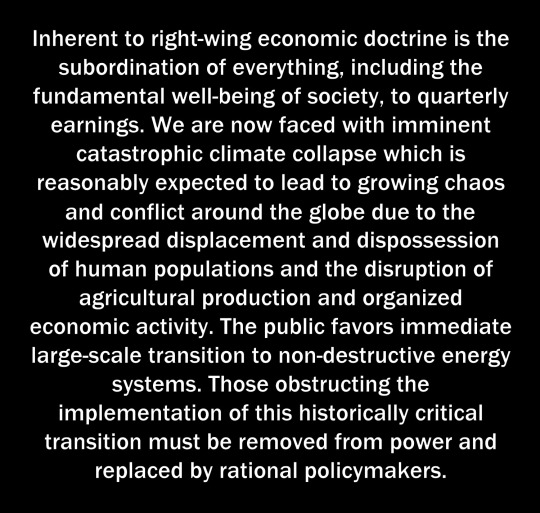
#climate crisis#right-wing assholes#corporate greed#republican assholes#climate refugees#republican hypocrisy#crooked donald#traitor trump#never trump
110 notes
·
View notes
Text
Patrick Michell has had his trailer packed and ready to go all week.
If he and his family have to flee the path of encroaching wildfires in British Columbia, it will be the second time in three years.
“Here’s where I’m at today,” Michell wrote to The Breach on Monday, attaching a photo of his utility trailer under a smoke-filled sky.
His family has owned the trailer since a record-breaking wildfire in 2021 burned their house down, along with the entire town of Lytton, B.C.
The day of the fire, Michell realized he wasn’t a mere evacuee.
“I was a refugee because I did not have a home to go back to,” the former chief of the Nlaka’pamux community Kanaka Bar said in an interview. “I want people to understand there’s a difference.”
Full article
Tagging: @politicsofcanada
#cdnpoli#canada#canadian politics#canadian news#canadian#climate refugees#climate injustice#Indigenous#First Nations#wildfires#fires#fire tw#Nlaka'pamux#kanaka bar#climate crisis#climate change#extreme weather#BC#british columbia
203 notes
·
View notes
Text
The production team behind the Little Amal puppet, which raised awareness about the plight of the refugee crisis in Europe, hope their next project – a herd of animal puppets going on a 20,000km trek – will start a new global conversation about the climate crisis.
Amir Nizar Zuabi, the Palestinian artist who helped launch the Amal project, said The Herd – which will tour through several African and European cities and feature dozens of puppets – will be a “soft, beautiful evocation to think differently” about the climate crisis.
#good news#global climate change#climate crisis#climate refugees#climate change#puppets#free palestine#environmentalism#environment#nature#animals#conservation#europe#africa#art#The Herd
22 notes
·
View notes
Text
Climate-Endangered Tribe Sues Louisiana

By now, you're likely well aware of the climate crisis and its significant dangers to Indigenous communities the world over. The problem is especially magnified on islands and in coastal regions, where sea level rise can wipe away traditional homelands and make climate refugees of those who have been displaced. That's true even right here in the United States, where hundreds of Native communities -- in South Dakota, Alaska, Florida, Hawai'i, Washington, and Louisiana -- face existential threats.
And now, the first community to supposedly be moved from harm's way -- the Jean Charles Choctaw Nation -- is facing a new set of problems. Just before the new year, the tribe filed a landmark civil rights complaint with the U.S. Department of Housing and Urban Development (HUD) against the state of Louisiana. In 2016, HUD granted Louisiana $48 million in aid to resettle the tribe. But, its complaint asserts, Louisiana failed to properly implement the grant and has ethnically and racially discriminated, violated tribal sovereignty, excluded cultural components central to a proper relocation program, and provided poor replacement housing.
The Jean Charles Choctaw Nation has resided on the Isle de Jean Charles for five generations, since the ancestors of its citizens escaped the Trail of Tears in the early 1830s amid President Andrew Jackson's Indian Removal Act. Its homelands and burial grounds are located in a region facing perpetual devastation and erosion by storms and sea level rise. Since 1955, the Jean Charles Choctaw Nation has lost over 98 percent of its lands to the encroaching ocean.
It's also worth noting that the tribe is located in Terrebonne Parish, a region notorious for oil extraction, high pollution rates, and environmental justice violations. The Parish and over 90 percent of its property are largely controlled by non-local fossil fuel and chemical companies. The infamous "Cancer Alley" is just upstream.
By filing its complaint with HUD, the Jean Charles Choctaw Nation is looking to the federal agency to investigate the grant-funded resettlement program, currently run by Louisiana's Office of Community Development (OCD). The tribe hopes HUD will order OCD to respect tribal needs and authority as the program's implementation proceeds. The lawsuit is also significant in that, while the tribe has state recognition from Louisiana, it does not have federal recognition, which would extend access to more grants, disaster assistance, and various legal powers -- including constitutional protections and self-governance recognized by the United States.
#climate change#indigenous cultures#indigenous rights#climate refugees#native americans#choctaw nation
10 notes
·
View notes
Text
The far right has now become the leading political cause of climate disaster. In the US, the far right and the Republican Party are increasingly one and the same.
A recent paper in the scientific journal Nature identifies the “human climate niche”: the range of temperatures and rainfall within which human societies thrive. We have clustered in the parts of the world with a climate that supports our flourishing, but in many of these places the niche is shrinking. Already, around 600 million people have been stranded in inhospitable conditions by global heating. Current global policies are likely to result in about 2.7C of heating by 2100. On this trajectory, some 2 billion people may be left outside the niche by 2030, and 3.7 billion by 2090. If governments limited heating to their agreed goal of 1.5C, the numbers exposed to extreme heat would be reduced fivefold. But if they abandon their climate policies, this would lead to around 4.4C of heating. In this case, by the end of the century around 5.3 billion people would face conditions that ranged from dangerous to impossible.
As the climate situation grows worse, the far right climate deniers become increasingly shrill and aggressive. Extremists have made climate denial part of culture wars.
Culture war entrepreneurs, often funded by billionaires and commercial enterprises, cast even the most innocent attempts to reduce our impacts as a conspiracy to curtail our freedoms. Everything becomes contested: low-traffic neighbourhoods, 15-minute cities, heat pumps, even induction hobs. You cannot propose even the mildest change without a hundred professionally outraged influencers leaping up to announce: “They’re coming for your ...” It’s becoming ever harder, by design, to discuss crucial issues such as SUVs, meat-eating and aviation calmly and rationally.
Climate science denial, which had almost vanished a few years ago, has now returned with a vengeance. Environmental scientists and campaigners are bombarded with claims that they are stooges, shills, communists, murderers and paedophiles.
Being in a place that's particularly sensitive to climate change does not mean you will automatically end up with more responsible leaders. Case in point: Florida Gov. Ron DeSantis.
In some cases, the cycle plays out in one place. Florida, for example, is one of the US states most prone to climate disaster, especially rising seas and hurricanes. But its governor, Ron DeSantis, is building his bid for the presidency on the back of climate denial. On Fox News, he denounced climate science as “politicisation of the weather”. At home, he has passed a law forcing cities to continue using fossil fuels. He has slashed taxes, including the disaster preparedness sales tax, undermining Florida’s capacity to respond to environmental crises. But the hard right thrives on catastrophe, and again you get the sense that it can scarcely lose.
Tackling climate change internationally reduces the flow of climate refugees in the medium to long term. The GOP solution is to have corrupt contractors build third-rate walls and to dump migrants in the states of political opponents.
If you want to know what one possible future – a future in which this cycle is allowed to accelerate – looks like, think of the treatment of current refugees, amplified by several orders of magnitude.
The international far right thinks refugee-hatred is more politically advantageous to them than mitigating climate change.
Already, the manufactured hatred of refugees has helped the far right to gain or share power in Italy, Sweden and Hungary, and has greatly enhanced its prospects in Spain, Austria, France and even Germany. In every case, we can expect success by this faction to be followed by the curtailment of climate policies, with the result that more people will have no choice but to seek refuge in the diminishing zones in which the human climate niche remains open: often the very nations whose policies have driven them from their homes.
It is easy to whip up fascism. It’s the default result of political ignorance and its exploitation. Containing it is much harder, and never-ending. The two tasks – preventing Earth systems collapse and preventing the rise of the far right – are not divisible. We have no choice but to fight both forces at once.
In the US, 98% of all Democratic candidates are better than 98% of Republican candidates on climate change. There are rare exceptions, and nobody is 100% perfect. But the best way to fight both fascism and climate change is to vote Democratic and not to miss a single election for any level of government.
Biden gets backing of leading environmental groups for re-election
Be A Voter - Vote Save America
#climate change#the far right#fascism#climate deniers#republicans#the gop#culture wars#ron desantis#florida#climate refugees#climate migration#election 2024#register and vote#vote democratic#george monbiot
12 notes
·
View notes
Text
6 notes
·
View notes
Text

Happy World Environment Day! The best way to celebrate is to think and educate yourself on the ways that climate, and radical rethinking of how to save our earth, involves thinking about how climate change is mainly about the people and the marginalized communities; their hunger, their homes, disease and disaster. Plant trees, recycle, but make sure to push your activism farther. Think about the larger changes that need to be made on a level much bigger than individual eco-friendly choices.
The theme for World Environment Day this year is “Only One Earth”, with focus on “living sustainably in harmony with nature”.
"World Environment Day #OnlyOneEarth calls for collective transformative action on a global scale to celebrate, protect and restore our planet, our common home.”
#world environment day#environment#climate refugees#climate change#climate action#climate justice#climate crisis#climate emergency#climate denial#climate activism#climate anxiety#climate solutions#mother earth#earth day#climate change is real
62 notes
·
View notes
Text
#Athens | Protests continue in #Greece for the hundreds of #refugees who went missing (died) in the #shipwreck off #Pylos.
People concerned about the cover-up of the crime and demanding accountability from the authorities have declared a nationwide day of action today.
"Pylos was a mass murder by the Greek state and European Union"
#athens street art#athens#greece#political refugees#afghan refugees#united nations high commissioner for refugees#rohingya refugees#syrian refugees#refugees welcome#reddit refugees#climate refugees#jewish refugees#refugees#shipwreck#pylos#ausgov#politas#auspol#tasgov#taspol#australia#neoliberal capitalism#fuck neoliberals#anthony albanese#albanese government#racism 101#racist#fascists#fuck fascism#the gop are fascists
3 notes
·
View notes
Text
The Lincoln Heights community endured for decades, despite segregation, economic hardship and a pandemic. Then came the Mill fire.
When the Mill fire ripped through Weed, Calif., just before Labor Day weekend, the hardest-hit area was a historically Black neighborhood that dates back nearly a century.Credit...Brian L. Frank for The New York Times
Oct. 7, 2022
WEED, Calif. — The gray rubble appears suddenly on both sides of the highway winding through this small Northern California town, as houses give way to a landscape of charred wreckage and the remains of homes, bleached white by wildfire.
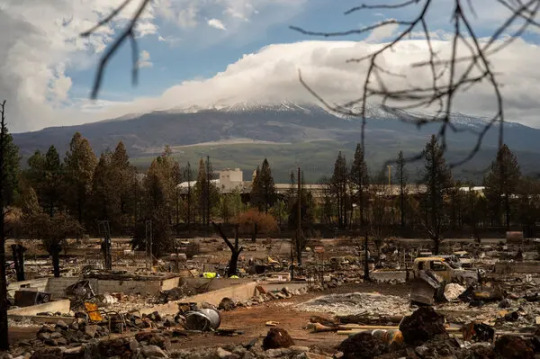
The devastation stretches for blocks. Metal skeletons of cars and blackened trees indicate where properties once stood in the shadow of Mount Shasta.
This neighborhood, Lincoln Heights, was once the thriving and vibrant home of a Black community — a rare sight in predominantly white, rural Siskiyou County, which hugs the Oregon border. Black laborers moved here from Louisiana, Mississippi and Arkansas to work at a lumber mill in the 1920s, and their descendants continued to live in houses on the outskirts of town, passed down through generations.
For decades, the mill next to Lincoln Heights offered opportunity and hope for those seeking a job and a better life. Now, residents see it as a symbol of the neighborhood’s destruction. Roseburg Forest Products, the mill’s owner, has said it is investigating whether hot ash in its facility started the Mill fire, which ripped through Lincoln Heights before exploding to 4,000 acres in early September.
In Weed, the Mill fire consumed most of Lincoln Heights, killing two people and destroying nearly 60 homes. The park that served as a gathering place is all that remains of the eastern side of the neighborhood.
“You can build that house back. But that home is a most special place,” said Andrew Greene, 84, who raised his children in Lincoln Heights. “It’s a place of culture, it’s a place of growth, it’s a place of remembrance and most of all it’s a place of love.”
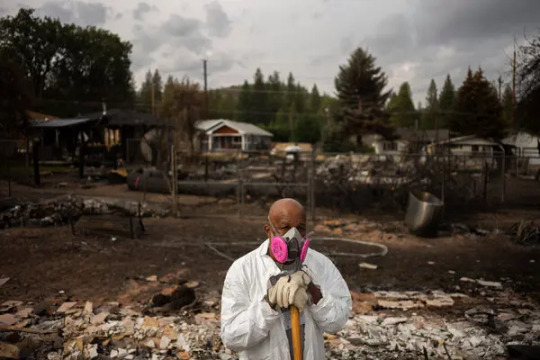
The rapid blaze was the latest in a series of fires in California that, as the climate warms, have leveled neighborhoods like Coffey Park in Santa Rosa, or towns like Paradise and Greenville. That devastation has forced wildfire victims to choose between rebuilding or starting life anew elsewhere.

The hints of life from before the fire are few in Lincoln Heights. A child’s bicycle abandoned on the side of the road. A pocket watch peeking through debris. At one property, atop porch steps that lead nowhere, sits a vase of fresh flowers as a memorial.
Many residents have pledged to rebuild. But they worry that enough of their neighbors will flee to other cities for the spirit of the old neighborhood to be lost for good.
In the 1920s, hundreds of Black Southerners made the journey to rural Northern California, lured by the promise of employment, for $3.60 a day, at the sawmill owned by the Long-Bell Lumber Company, which had just closed two mills in Louisiana as it searched for untouched forests out west.
The company lent workers the train fare and provided them with wooden houses amid the aspens and pines in a small place called Weed. It was a company-owned, segregated town, and Black mill workers and their families were required to live on the northern outskirts. That neighborhood was known as the Quarters and, later, Lincoln Heights.
For decades, Black residents of Weed had their own church, barbershops and nightclubs, according to residents and a 2011 documentary about the neighborhood’s history produced by Mark Oliver, a filmmaker. They were prohibited from being buried in the white-only graveyard, so they had to dig their own. Black people could shop in some white-owned stores and cafes, but they couldn’t linger.
“Your parents would buy you an ice cream cone, you had to go outside to eat it — you couldn’t use the counter,” recalled Al Bearden, a retired probation officer who grew up in Weed.
At the sawmill, white workers were given safer, more lucrative jobs indoors. The only integration came at school — where white and Black children learned together before returning to their cloistered communities — and on the Weed Sons, the town’s baseball team.
That began to change in the 1950s and 1960s, when the civil rights movement slowly arrived in Siskiyou County. In Weed, Black residents arranged sit-ins at restaurants that wouldn’t serve them and boycotted businesses until they agreed to hire them.
Black residents said they still faced discrimination in subsequent years. At school, they said, white children would use racial slurs and make fun of those who had less money.
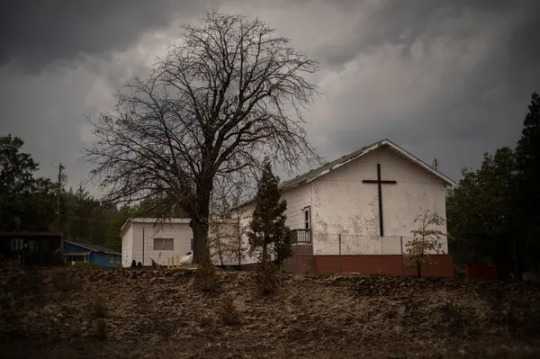
Lincoln Heights residents said theirs was the kind of neighborhood where children who were spotted misbehaving by a local elder could expect a call to their family home that evening. On Sundays, the Mt. Shasta Baptist Church was full.

The center of social life was 13-acre Charlie Byrd Park, named after the first elected Black sheriff in California, who grew up in Weed and led Siskiyou County’s law enforcement agency for 16 years.
“On the weekends, that was always packed,” said Lawrence Robison, 39, who grew up in the neighborhood. “Family gatherings, barbecues — just a place to go and relax at the end of the day.”
At work, times were getting tougher.
In 1982, the International Paper Company, which had succeeded Long-Bell, sold the sawmill to Roseburg Forest Products, a transaction that residents mark as the beginning of the decline of the local logging business. Around that time, advances in automation and a growing environmental movement curtailed lumber jobs.

Some found other lines of work, at the local community college, the water bottling plant and restaurants, or in nearby towns. But others left the region entirely. In 2020, nearly a third of Weed households lived below the poverty line, according to census data.

As longtime Lincoln Heights residents moved to bigger cities, Mexican, Laotian, Filipino and white families took their place. Members of the younger generations said it is now much more common to see people with different racial and economic backgrounds mingling than it was when their parents were children.
“It was a change, but it was a good change,” said Angel Whatley, 24, who grew up in Lincoln Heights.
Weed likes to present its diversity as a success story. Mayor Kim Greene, who is white, calls the city “the melting pot for all the nationalities.”
The city accounts for 6 percent of the population in Siskiyou County, but has 36 percent of the county’s Black residents, based on 2020 census data. It also has a higher share of Hispanic and Asian American residents than the county as a whole.
Still, Black residents say the decades-old struggle for fair treatment continues. Mayor Pro Tem Stacey Green, who is Black, said racism in Weed is “sneaky.”
“It’s behind your back,” he said.
Mr. Green said the city didn’t repave a road in Lincoln Heights until he threatened to call the National Urban League, a civil rights group, while a new street sweeper never made an appearance in the neighborhood until he complained.
The city manager, Tim Rundel, said he understood how Mr. Green and some residents might feel. But, he said, narrow streets in the old neighborhood have made it challenging for street sweepers and snowplows to navigate around parked cars. “It’s been a struggle in Lincoln Heights and other neighborhoods throughout Weed,” he said.
More than 250 miles north of San Francisco, Siskiyou County is still a place where residents scorn the state’s Democratic leadership. Though Weed is more liberal than Siskiyou County as a whole, some Lincoln Heights residents say the presidency of Donald J. Trump deepened political and racial tensions in town.
On the surface, people in Weed “still get along quite well,” Andrew Greene said. But he takes pains to avoid topics that could cause tempers to flare.

“The two rules of the bar — two things you don’t discuss or you shouldn’t discuss: One is politics, the other is religion,” Mr. Greene said.

In the early afternoon of Sept. 2, Weed was sweltering as California braced for the beginning of a record heat wave. Fierce wind gusts brought some relief, but also threatened to send flames and embers flying.
Just before 1 p.m., Pastor Alonzo Greene, Andrew’s son, was standing on the front porch of his childhood home in Lincoln Heights with his wife, smiling proudly because his adult children had just finished moving into the old wooden house his grandparents had built.
Down the block, his father was sitting down for lunch. Suddenly, he heard frantic knocking on his door. “Fire,” his neighbor gasped out.
Then they heard a boom.
In what felt like an instant, the neighborhood was engulfed in smoke, and the billowing winds sent flames from the direction of the mill into the neighborhood.
The younger Mr. Greene plunged into the smoke, kicking in neighbors’ doors and hauling children, pets and seniors into his pickup truck. His father rushed a neighbor and the child she was babysitting into his own truck and started driving blindly through the haze, trusting his memory of the road to guide them to safety.
A few blocks away, Patricia Mitchell’s phone was ringing. It was her sister, asking about the smoke nearby.

“So I got up and went, ‘Well, I don’t see nothing,’” recalled Ms. Mitchell, 68. “The next thing I know, there’s black smoke everywhere.”
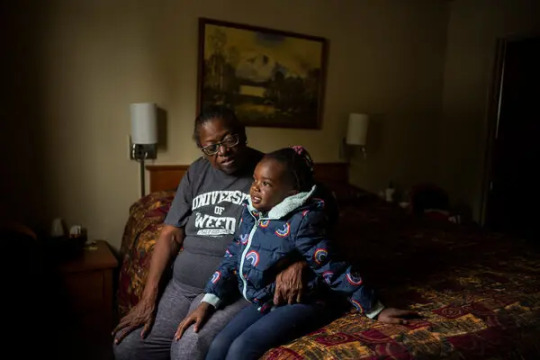
She escaped, but her house and all of her possessions — including her wedding ring and coin collection — were gone.
“Every time I think about this fire, it brings me down, because so much was lost,” she said.
Mr. Green, the mayor pro tem, was also in trouble. He rushed out of his house without shoes, into the thick smoke.
“I couldn’t see any skies, and it started getting into my lungs,” he recalled. “I thought, ‘I’m going to die right now.’”
Finally, he saw a glimmer of blue above him and made it to safety.
“My life started there: My first tricycle ride was down my driveway, my first birthday party. And everything I knew was all there — pictures of my parents on the wall. I don’t have none of that left,” Mr. Green said, choking up.
Not everyone in Lincoln Heights survived. Two women, Marilyn Hilliard, 73, and Lorenza Glover, 65, died in the fire. Three others, including Ms. Hilliard’s husband, were injured.
At least three lawsuits have been filed against Roseburg, including a wrongful-death suit by Ms. Glover’s son that says she died as she tried to escape the flames. Ms. Hilliard died of a heart attack during the fire, residents said.
Roseburg officials said the company will provide $50 million for a “community restoration fund,” but that the money is not an admission of liability.
“We’re committed to doing the right thing for Weed, for Lake Shastina, for the long haul,” said Pete Hillan, a Roseburg spokesman.
Mr. Green wasn’t satisfied. “You’re trying to give $50 million to shut our mouths,” he said.
In the weeks since the fire, Lincoln Heights residents have scattered to nearby towns, staying with relatives, filling motels and finding temporary housing. Not everyone plans to return. Many lack the money or insurance to rebuild.
“I’ll move on — I’ll move to L.A.,” said R.T. Smith, who lost his house and all his possessions in the fire. “I’m about tired of this little town,” he added.
Others hope to restore the community. In mid-September, several dozen displaced residents were staying at the Hi-Lo Motel in Weed, where Alonzo Greene led them in a brief prayer twice a day.
“If I broke down and started crying, it really shook all of these people,” he said. “So I had to get to a point where I just take a drive by myself if I want to cry, because I couldn’t let them see it.”
He paused for a moment, gathering himself. “It’s been tough.”
#Wildfire Destroys a Piece of Black History in Rural California#Mill Fire#Weed Fire#Black California#Fires#Climate Change#climate refugees#Mt.Shasta#Lincoln Heights
8 notes
·
View notes
Text
This article doesn't avoid discussing managing forced migrations and suggests that there may be positives for the host nations.
#jail climate criminals#we want climate action now#climate change#climate crisis#climate refugees#climate migration#qihou bianhua#cambio climático#klimawandel#klimakatastrophe#hurricanes#kiribati#changement climatique#climate criminals#sea rise#sea level rise#droughts
3 notes
·
View notes
Text
People are always going on about how it's not their lifestyles that cause climate change rather it's massive corporations.
That much is very true but what they often leave out is that stopping those corporations from polluting will render their lifestyles impossible anyways.
No matter what path you choose your lifestyle will change, today or tommorow but it will.
And no you can't just go natural. Naturally sustaining current first world lifestyles will actually produce more pollution than doing it through the those massive corporations.
The truth is that no matter what, at current tech level we are set to live in a world with less food, less tasty food, cramped rooms, worse HVAC and weaker buildings.
And say goodbye to meat while we are at it, meat as it is now is completely unsustainable and laughably inefficient.
Lab grown meat? Maybe if technology reaches there in the next few decades.
Local is once again actually worse for emissions.
This is the cost of being sustainable and it's well worth it.
Otherwise, if you are in equatorial regions like me, God have mercy on you, because as many morden refugee crises have shown us, your fellow humans won't.
#climate crisis#climate change#environmentalism#anti consumption#sustainability#refugees#climate refugees
1 note
·
View note
Text
youtube
The most habitable planet in the solar system is becoming increasingly less so. Millions of people will need to – and are already – leaving their homes in search of safer ones. Join me in one of over 1000 'ghost villages' in the Himalayas that are being deserted, as I try to understand its impact, and what might be done to slow down the soon-to-be Greatest Migration on Earth.
Credits
Reporter: Aditi Rajagopal
Camera: Ishaan Chawla & Braj Kishore
Video Editor: Philipp Czegka
Supervising Editor: Kiyo Dörrer
We're destroying our environment at an alarming rate. But it doesn't need to be this way. Our new channel Planet A explores the shift towards an eco-friendly world — and challenges our ideas about what dealing with climate change means. We look at the big and the small: What we can do and how the system needs to change. Every Friday we'll take a truly global look at how to get us out of this mess.
#PlanetA #ClimateMigration #GhostVillages
Read more:
Future of the Human Climate Niche: https://www.pnas.org/doi/full/10.1073...
World bank report: https://www.worldbank.org/en/news/fea...
Vulnerability of Indian migrants: https://www.nature.com/articles/s4155...
Climate migrants and refugees: https://www.brookings.edu/research/th...
Chapters:
00:00 Introduction
01:17 Why are people leaving?
02:12 The changing monsoon
02:58 Blurry definitions
04:59 Life on the move
06:00 Migrants once more?
06:24 The future of conflict
07:12 The mountains need mountain people
08:12 Potential solutions
09:38 Conclusion
#dw planet a#solarpunk#migration#ghost town#ghost villages#ghost village#ghost towns#Himalayas#Asia#Greatest Migration#climate crisis#climate chaos#climate change#global heating#global warming#monsoon#climate refugees#Youtube
4 notes
·
View notes
Text

View on Twitter
The climate crisis is not a standalone issue; it’s a product of a long history of exploitation, of inequality, of accumulation.
🌏🌍🌎
(Source)
4 notes
·
View notes
Text
Италия. Глобальный кризис. Будущее зависит от нас. 16 сентября 2023
https://creativesociety.com/ru/global-crisis-italy-the-future-depends-on-us
youtube
#Италия#итальянцы#Климат#climate change#climate crisis#глобальный кризис#climate refugees#climate#Italia#Italy#italiano#blog italiano#Youtube
2 notes
·
View notes
Text
Weather-related disasters and Internal displacements.

Weather-related disasters caused approximately 20,000 child displacements a day between 2016 and 2021, according to UNICEF's Children Displaced in a Changing Climate Report. Read the report
0 notes
Text
"“It was a very challenging effort and task, but it was all-hands-on-deck with all the different local organizations to be able to help these families through this trauma of fleeing their [homeland] to seek refuge because they had lost everything,” says Casimiro Rodriguez, Sr., president emeritus and founder of Hispanic Heritage Council of Western New York."
0 notes